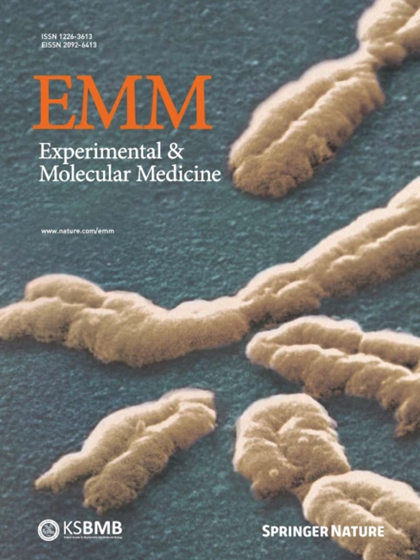Blockade of the vaspin–AP-1 axis inhibits arthritis development
IF 9.5
2区 医学
Q1 BIOCHEMISTRY & MOLECULAR BIOLOGY
引用次数: 0
Abstract
The trapping of pathogenic ligands can potentially be used to prevent signal transduction mediated by catabolic factor expression in osteoarthritis (OA). Although vaspin is known to function as a pathogenic ligand and represents a novel adipokine, little is known about its function and the impact of its nebulization-based administration in OA. Here we provide a report on the function of vaspin in articular chondrocytes and OA model mice. RNA sequencing analysis and ingenuity pathway analysis demonstrated that vaspin upregulation in chondrocytes triggers OA development-related signaling. Vaspin is upregulated in the injured cartilage of patients with OA and DMM (Destabilization of the Medial Meniscus) mice, and its overexpression induces catabolic factor expression in vitro under OA-mimicked conditions. Col2a1–vaspin Tg (Transgenic) animals showed extensive cartilage degradation, whereas vaspin−/− (knockout) mice exhibited decreased OA development. Furthermore, in silico and biochemical analyses showed that vaspin activates the p38 and JNK signaling pathways to regulate AP-1-driven catabolic factor production and cartilage breakdown. Finally, we identified and characterized a vaspin-targeting nanobody, vas nanobody, and showed that intraarticularly injected vas nanobody could effectively block the vaspin–AP-1 axis to treat OA in DMM mice. Together, our results suggest that blockade of the vaspin–AP-1 axis could be an effective therapeutic approach for preventing OA development. Osteoarthritis (OA) is a common joint disease that causes pain and stiffness. This study explores the role of a protein called vaspin in OA. Researchers collected cartilage samples from humans and mice to study vaspin’s effects. They found that vaspin levels were higher in damaged cartilage, suggesting it may worsen OA. To test this, they used mice genetically modified to produce more or less vaspin. Mice with more vaspin had worse OA symptoms, while those with less had milder symptoms. The team also developed a small antibody called a nanobody to block vaspin. When injected into mice with OA, this nanobody reduced cartilage damage and pain without causing side effects. The study concludes that targeting vaspin could be a promising new approach for treating OA. Future research may focus on developing nanobody treatments for human use. This summary was initially drafted using artificial intelligence, then revised and fact-checked by the author.

阻断 vaspin-AP-1 轴可抑制关节炎的发展。
致病性配体的捕获可以潜在地用于阻止骨关节炎(OA)中由分解代谢因子表达介导的信号转导。尽管已知vaspin是一种致病配体,代表一种新的脂肪因子,但对其功能和雾化给药对OA的影响知之甚少。本文报道了血管素在骨性关节炎模型小鼠关节软骨细胞中的作用。RNA测序分析和独创性途径分析表明,软骨细胞中vaspin上调可触发OA发育相关信号。Vaspin在OA和DMM (Medial半月板不稳定)小鼠损伤的软骨中表达上调,其过表达诱导体外模拟OA条件下分解代谢因子的表达。Col2a1-vaspin Tg(转基因)动物表现出广泛的软骨降解,而vaspin-/-(敲除)小鼠表现出OA发展减少。此外,硅和生化分析表明,vaspin激活p38和JNK信号通路,调节ap -1驱动的分解代谢因子产生和软骨破坏。最后,我们鉴定并表征了一种靶向vaspin的纳米体vas纳米体,并表明关节内注射的vas纳米体可以有效阻断vaspin-AP-1轴治疗DMM小鼠OA。总之,我们的研究结果表明,阻断vaspin-AP-1轴可能是预防OA发展的有效治疗方法。
本文章由计算机程序翻译,如有差异,请以英文原文为准。
求助全文
约1分钟内获得全文
求助全文
来源期刊

Experimental and Molecular Medicine
医学-生化与分子生物学
CiteScore
19.50
自引率
0.80%
发文量
166
审稿时长
3 months
期刊介绍:
Experimental & Molecular Medicine (EMM) stands as Korea's pioneering biochemistry journal, established in 1964 and rejuvenated in 1996 as an Open Access, fully peer-reviewed international journal. Dedicated to advancing translational research and showcasing recent breakthroughs in the biomedical realm, EMM invites submissions encompassing genetic, molecular, and cellular studies of human physiology and diseases. Emphasizing the correlation between experimental and translational research and enhanced clinical benefits, the journal actively encourages contributions employing specific molecular tools. Welcoming studies that bridge basic discoveries with clinical relevance, alongside articles demonstrating clear in vivo significance and novelty, Experimental & Molecular Medicine proudly serves as an open-access, online-only repository of cutting-edge medical research.
 求助内容:
求助内容: 应助结果提醒方式:
应助结果提醒方式:


